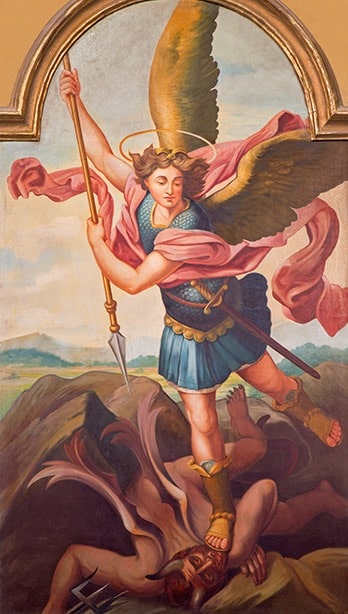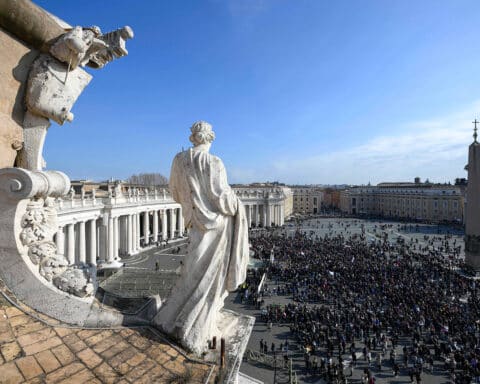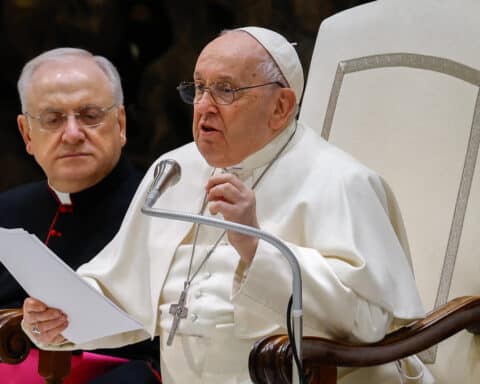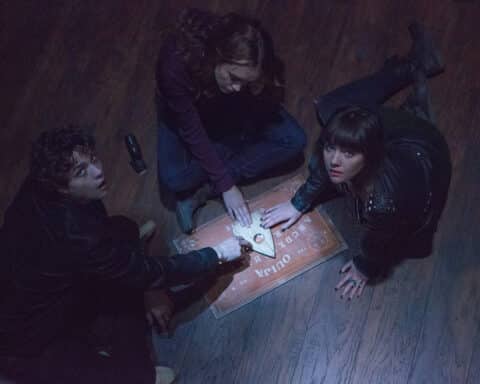St. Michael defeating Satan. Renata Sedmakova / Shutterstock
Old Scratch is back in the news. Recently, in an interview with Spanish newspaper El Mundo, Jesuit Superior General Father Arturo Sosa Abascal said: “We have formed symbolic figures such as the devil to express evil. Social conditioning can also represent this figure, since there are people who act [in an evil way] because they are in an environment where it is difficult to act to the contrary.”
Now, we create symbolic figures of real things all the time. So, for instance, we picture America as Uncle Sam. We picture God as the old man on a cloud on the ceiling of the Sistine Chapel. We picture a real (though abstract) thing like justice as a blindfolded woman with scales in her hand.
When we do that, we are not saying there is no such thing as America, God or justice. Likewise, when we picture a figure with pitchfork, bat wings, red tights and cloven hoofs, we don’t necessarily mean there is no such thing as the devil.
But Father Sosa did not say, “We form symbolic figures to express the reality of the devil.” He said we form symbolic figures like the devil in order to express evil. In short, he strongly suggested there is no such thing as the devil or demons and that they are figments of human imagination to express the abstraction we call evil.
If that is what he meant, then it is, not to put too fine a point on it, directly contrary to the teaching of the Catechism of the Catholic Church, which states that the devil is a real being, specifically a fallen angel who rebelled against God:
“The Church teaches that Satan was at first a good angel, made by God: ‘The devil and the other demons were indeed created naturally good by God, but they became evil by their own doing'” (No. 391).
Scripture speaks of a sin of these angels. This “fall” consists in the free choice of these created spirits, who radically and irrevocably rejected God and his reign.
In short, demons are not myths but realities preached by Jesus Christ, the apostles and a host of saints down the ages.
Some complain that the devil is a cop-out for human evil and an attempt to exonerate us of all responsibility for our sins. But this is a straw man that is directly contradicted by Tradition. Why the constant call to repentance if we have no responsibility for sin?
Others complain that the devil has been elevated to the equal and opposite of God. This may well be true for many individual Christians, but it is emphatically not true of the Church’s teaching.
Tradition insists that a devil is a mere creature: a non-corporeal angelic spirit that radically has perverted all its gifts of power, intelligence and will in a single, fixed choice to reject God (and all the good things he has made, including us) and, as it were, “assert its nothingness” in a nihilistic war on existence.
Some speak of demons as “pure evil.” But insofar as they are his creatures, God maintains a sort of beachhead in their natures. So demons retain the goods of existence, intelligence, will and power that God gave them, albeit radically perverted in rebellion against him. If they were “pure” evil they would cease to exist, since existence is a good.
Others, who conceive of spirits as something “more evolved” than corporeal creatures like us, imagine no spirit can be evil. But, as C.S. Lewis points out, there is nothing specially fine about being a spirit — and precisely the proof is that the devil, who tempts, accuses and lies, is a spirit.
Demons are enemies of God because of pride. So they do what all terrorists do: They harm those he loves because they cannot harm him. That is, they harm us — or seek to do so.
Such harm is not primarily physical (though the devil does enjoy seeing us suffer). Rather, the primary warning of Jesus is not to fear harm to the body but to fear the destruction of the soul (see Mt 10:28) that comes from giving in to the temptation to sin — the prideful rejection of God.
Interestingly, Tradition tells us that the devil’s motivation in tempting us to imitate his rebellion was envy (see Wis 2:24), both of God and of human beings, made in his image and likeness and, most especially, made to partake of his divine nature in baptism. By nature, the angels are greater than we. But by grace, we are raised far above them. In their spite demons attack us for this. But as Tradition reveals, the Son of God came to destroy the works of the devil. “Resist the devil,” says James 4:7, “and he will flee from you.”





